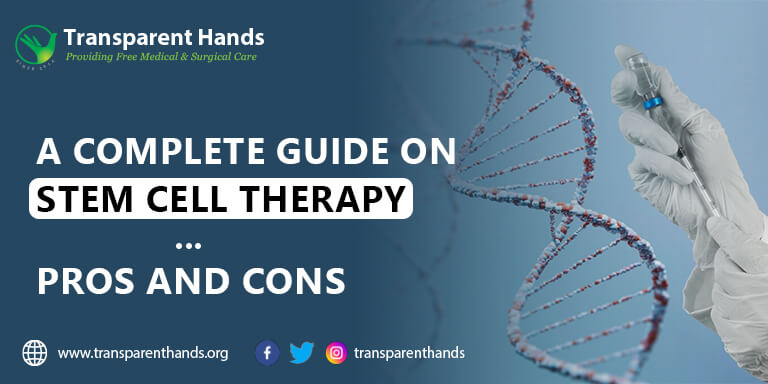A Complete Guide on Stem Cell Therapy

Stem cells are undifferentiated cells that can transform into any type of cell in the body. This ability paves a promising way of using them to repair damaged tissues and organs. Stem cell therapy is a rapidly developing field of medicine and has been revolutionary in the treatment of many injuries and diseases. Let’s read a complete guide on stem cell therapy with its pros and cons.
What Does Stem Cell Therapy Do?
The principle of the therapy is simple, stem cells are introduced into the body to help repair damage. They can be injected directly into the harmed area or can be used to create new tissue or organ which is then transplanted into the body.
How Stem Cell Therapy Is Done
The steps involved in the execution of stem cell therapy are different depending on the condition being treated and the type of therapy being done. However, here are a few steps that are common to most:
1. Stem cells can be collected from different parts of the body, such as bone marrow, blood, umbilical cords, and fat tissue.
2. The stem cells are then processed to prepare them for transplantation. This may involve purifying them or growing them in a lab to increase their number.
3. The stem cells are transplanted into the body through an injection, infusion, or surgery.
4. Once transplanted, the stem cells differentiate into the specific types of cells needed to repair the tissue or organ.
Types of Stem Cell Therapy
There are two main types of stem cell therapy: autologous and allogeneic.
Autologous stem cell therapy: In autologous therapy, the stem cells are collected from the patient’s own body. This therapy type is usually used to treat cancer among other blood disorders.
Allogeneic stem cell therapy: The stem cells in allogeneic therapy are collected from another person, such as a donor or sibling. This therapy type is used to treat patients who have undergone radiation or chemotherapy, and patients who have leukemia or other blood disorders.
NGOs Providing Free Chemotherapy in Pakistan
Potential Risks of Stem Cell Therapy
Stem cell therapy is generally safe, but there is a risk of side effects, such as infection and rejection. The risk of side effects depends on the type of stem cell therapy used and the patient’s individual health condition.
Stem cell therapy is generally considered safe but like with most medical procedures there is a risk of side effects such as rejection and infection. The side effects are dependent on the patient’s individual health and the type of stem cell therapy used.
Infection: Infection is one of the most common risks associated with stem cell therapy. The reason is that stem cells are usually transplanted into a weakened immune system and to reduce the risk, patients are prescribed antibiotics before and after the procedure.
Rejection: Another common risk that patients are susceptible to is rejection. It happens when the patient’s immune system attacks the transplanted stem cells. Patients are usually given immunosuppressive drugs after the procedure to reduce the risk.
Other potential risks of stem cell therapy include:
- Tumor formation is another risk that transplanted stem cells pose. The risk is higher in patients who previously have had cancer.
- There is a small risk that transplanted stem cells could undergo genetic changes which could lead to cancer or other health issues.
- In some cases, the transplanted cells trigger an autoimmune reaction where the body’s immune system starts attacking its own healthy cells.
What Diseases Can Be Cured by Stem Cells?
Stem cell therapy has been used to treat a wide range of conditions such as repairing damaged heart muscle after a heart attack, killing cancer cells or replacing damaged blood cells for cancer patients, repairing brain tissue after a stroke, kidney diseases, and more. The results so far have been impressive as stem cells are now even being explored as a potential treatment for Alzheimer’s.
Pros and Cons of Stem Cell Therapy
Pros:
Can be used to treat a wide range of injuries and diseases.
Can repair damaged tissue and organs that can improve quality of life.
Shown to be effective and safe in numerous clinical trials.
Cons:
Can be expensive.
Risk of side effects.
Not yet available for all injuries and diseases.
Other Potential Applications of Stem Cell Therapy
Stem cell therapy is also being investigated as a potential treatment for a variety of other conditions, including:
1. Diabetes
2. Parkinson’s disease
3. Multiple sclerosis
4. Amyotrophic lateral sclerosis (ALS)
5. Arthritis
6. Crohn’s disease
7. Ulcerative colitis
8. Burns
9. Hair loss
The Future of Stem Cell Therapy
Stem cell therapy is a rapidly evolving field of medicine and holds significant potential to revolutionize treatment for numerous injuries and conditions. Researchers are currently working on developing new and improved therapies and making them more accessible to patients.
It can treat many diseases that are currently incurable and improve the quality of life of those suffering from chronic illnesses.
How effective is Stem Cell Therapy?
Conclusion
Despite its revolutionary ability to treat a myriad of diseases and promising potential to help others, stem cell therapy is still in the early stages of development. Like all medical procedures, it comes with its risks as well.
If you are considering stem cell therapy, after reading this complete guide on stem cell therapy, make sure to talk to your doctor if it is the right option for you. Likewise, make sure to choose a reputable medical facility that has experienced stem cell therapy providers.










Leave Your Comments